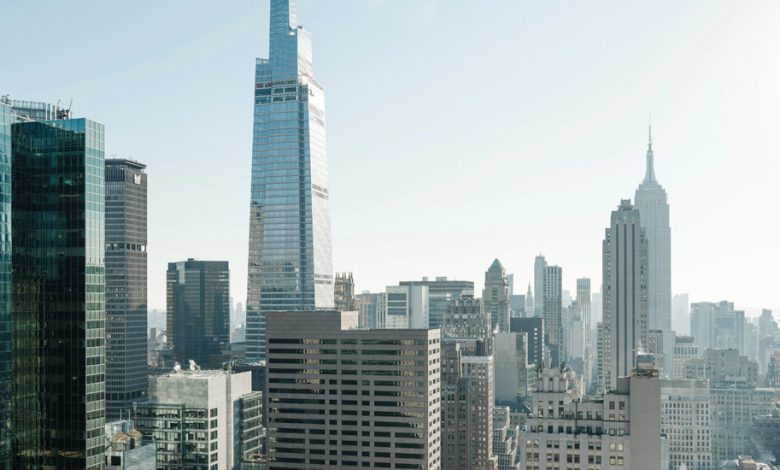When a Green Building Is No Longer Green Enough

Good morning. It’s Wednesday. Today we’ll look at a building that was built to be an environmental showpiece, but it’s already out of date — and it has been open only since late 2020.

Credit…Karsten Moran for The New York Times
It reached for the sky and also for the future: The building just west of Grand Central Terminal in Midtown Manhattan that’s known as One Vanderbilt had remarkable ambitions when it opened in late 2020. It was designed with climate change in mind, with green features like a self-contained power plant that could generate as much energy as six football fields of solar panels. But it is already out of date. Our reporter Ben Ryder Howe says that the building’s most important green features were the right answers on climate change when it was being planned, but in the six years since the groundbreaking ceremony, the answers have changed. I asked him to explain.
You write that One Vanderbilt is already dated. How so?
The main thing is that it uses natural gas, which is not the future of New York City. New York’s energy future is all-electric.
Fossil fuels like gas, despite how clean gas is compared with other fossil fuels, are on the way out, and they’re on the way out quickly.
In 2021, around the time One Vanderbilt opened, the city passed a law effectively banning fossil fuels in large buildings starting in 2024 and smaller ones in 2027. This law had been in the works for some time, and even when One Vanderbilt was being built, the owners knew that things were likely to change.
That, I think, is part of a larger story. Even when builders are reasonably certain that changes are coming, they can’t just stop and wait. Nor do they know how new laws will shake out.
Another hugely consequential law, Local Law 97, was passed in 2017. It essentially puts buildings on a carbon diet. What’s revolutionary about Local Law 97 is that it applies to existing buildings as well as new construction. Tens of thousands of buildings much smaller than One Vanderbilt are going to be affected. But even now, four years later, the city has yet to say what the penalties will be. Nor is it clear how aggressively the law will be enforced. Imagine opening a $3 billion skyscraper with that kind of uncertainty.
One Vanderbilt is an engineering marvel, and for me as a reporter, it was fascinating to spend time with the engineers as they showed it off. Commercial developers like SL Green, the company behind One Vanderbilt, are the only ones with the money and wherewithal to make those big technological leaps. The people who run One Vanderbilt are proud of the building, and it shows.
To then find out that a building that has won all these awards for sustainability is facing the possibility of retrofitting after a relatively short time, that’s fascinating, too.
There aren’t a lot of buildings in the city that generate their own electricity the way One Vanderbilt does, are there?
There are some. It was trendy for a while because landlords saw it as a money-saver: Basically they could burn gas and get both electricity and hot water. Environmentalists liked it because they weren’t using oil or coal.
It also allowed buildings to supplement the electricity they get from the grid, which helps Con Ed avoid the use of peakers, the power plants that come online when the grid is strained. Those plants are expensive, inefficient and often powered by fossil fuels.
Also, an on-site power plant isn’t dependent on transmission lines. A lot of electricity is lost along the way from where it’s generated, usually upstate.
What else about One Vanderbilt makes it environmentally friendlier? Doesn’t it have a system that captures rainwater and uses it in the building? Is that system obsolete?
Not at all. But it does show how quickly, as the climate debate races forward, dire concerns can feel like yesterday’s struggle.
After Hurricane Sandy, a big environmental concern was resiliency. One Vanderbilt has one obvious feature of buildings constructed when that was top of mind: A lot of its machinery is well above the basement.
One Vanderbilt also has giant holding tanks, enabling it to retain the water it captures from its own surface and recirculate it throughout the building. That helps the building avoid dumping runoff into the sewer, which was a huge concern not just post-Sandy but after those crazy, once-in-a-lifetime storms just a year and a half ago.
The next large sustainable building is not far away — the JPMorgan Chase building at 270 Park Avenue. How long before it’s obsolete?
Who knows? Things are changing quickly. That building is massive — it’s only half-built, yet it seems to cast a shadow down Park Avenue — and it has no gas or steam line. That’s the all-electric future, which, writ large, is going to make New York the world leader on sustainability, if it happens.
But there are questions about where the energy is going to come from and how it’s going to be delivered. So it’s not a small bet.
Will SL Green replace the gas-powered turbines that generate the electricity at One Vanderbilt?
Their answer, when I asked them, was T.B.D. They’re waiting to see how Local Law 97 shakes out.
I wouldn’t be surprised if they don’t have to? The most impressive thing about One Vanderbilt is how interconnected all the systems in it are, and the way those systems work together to respond to the external environment and self-regulate, almost like a plant. It’s finely balanced, and to replace the power system feels like it would throw everything off.
Weather
Prepare for a chance of rain or snow, possibly continuing through the evening, with temperatures hitting the mid-40s. At night, temps will drop to the mid-30s.
ALTERNATE-SIDE PARKING
Suspended today (Ash Wednesday).
The latest New York news
-
Big-city mayors: Since December, the nation’s four largest cities have all had Black mayors. They have banded together as they confront a rise in crime, homelessness and other similar challenges.
-
The dangers of “subway surfing”: In New York, incidents of people riding outside of train cars have more than quadrupled in one year. Two recent deaths show the dangers of a trend stoked by social media.
-
A record warm winter: A wildly erratic season has been a blessing for haters of mittens and blizzards, but a potential disaster for businesses that rely on snow and ice.
Crime
-
Arson and possible hate crime: A woman set fire to Little Prince, a restaurant in SoHo, by igniting a gay pride flag hanging on the business’s facade in an act of arson that was being investigated as a possible hate crime, the police said.
-
García Luna trial: A Brooklyn jury found Genaro García Luna guilty of taking millions of dollars from the Sinaloa drug cartel when he was in charge of Mexico’s bloody war on organized crime.
Arts & Culture
-
Celebrating Yoko Ono: At 90, Yoko Ono has outlasted her detractors, just as she more or less predicted she would. To commemorate her birthday on Saturday, more than 50 artists and fans gathered in Central Park to take part in “Morning Piece for Yoko Ono.”
-
Dudamel meets New York: On Gustavo Dudamel’s first visit to the city since being named the New York Philharmonic’s next music director, he eagerly played the role of celebrity conductor.
METROPOLITAN diary
Subway sandwich
Dear Diary:
I got on the Q at 96th Street. I was on my way to Hell’s Kitchen to grab a quick dinner before watching “RuPaul’s Drag Race.”
A woman got on at 86th Street and sat right next to me. She was probably in her 50s, had a full head of curly blond hair and was getting off a call since she was about to lose service.
As we approached 72nd Street, the woman searched through her purse and pulled out a sandwich: smoked salmon on pumpernickel bread.
The train was packed, but she was determined to eat this sandwich. As we approached 63rd Street, she started to rummage through her bag again. This time, she pulled out a pepper grinder.
Apparently oblivious to everyone around her, she disassembled the sandwich, ground some fresh pepper onto the salmon and put the grinder back in her bag. Then she started eating.
Now everyone was staring at her. Some people were chuckling to themselves.
“Wow,” one man said to the woman. “That was quite the experience. Never seen that one before.”
She cleared her throat and smiled.
“This is New York City,” she said. “I always carry my pepper grinder. You never know when you’ll need it.”
— Lala Tanmoy Das
Illustrated by Agnes Lee. Send submissions here and read more Metropolitan Diary here.
Glad we could get together here. See you tomorrow. — J.B.
P.S. Here’s today’s Mini Crossword and Spelling Bee. You can find all our puzzles here.
Melissa Guerrero and Ed Shanahan contributed to New York Today. You can reach the team at [email protected].
.




